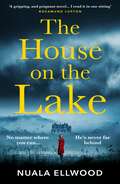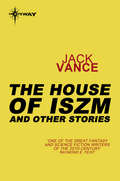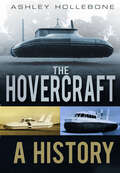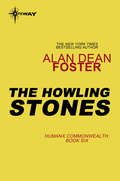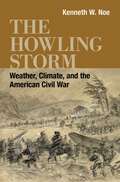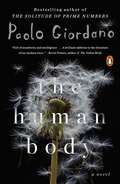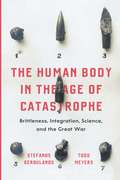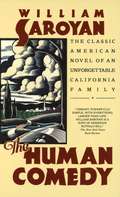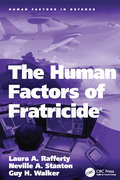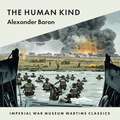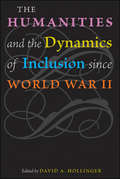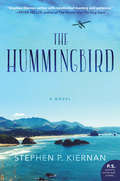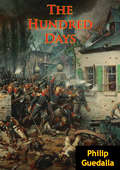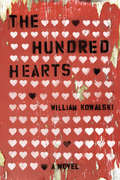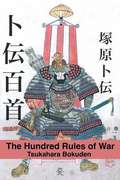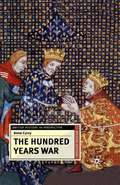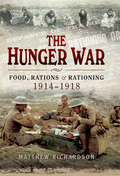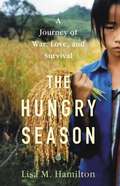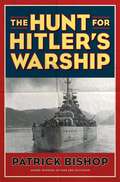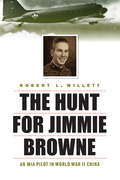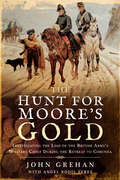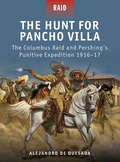- Table View
- List View
The House on the Lake: The new gripping and haunting thriller from the bestselling author of Day of the Accident
by Nuala EllwoodNo matter how far you run . . .He's never far behind'Gripping, poignant' Rosamund Lupton'Eerily haunting' Jane Corry'I literally couldn't put it down' Emma Curtis__________________________________________Lisa needs to disappear. And her friend's rambling old home in the wilds of Yorkshire seems like the perfect place. It's miles away from the closest town, and no one there knows her or her little boy, Joe.But when a woman from the local village comes to visit them, Lisa realizes that she and Joe aren't as safe as she thought.What secrets have Rowan Isle House - and her friend - kept hidden all these years?And what will Lisa have to do to survive, when her past finally catches up with her?**BUY THE SPELLBINDING THRILLER FROM THE BESTSELLING AUTHOR OF DAY OF THE ACCIDENT AND MY SISTER'S BONES**__________________________________________WHAT THEY'RE SAYING ABOUT NUALA ELLWOOD'Creepy and deliciously atmospheric, this page-turner has it all - twists and turns and a powerful emotional punch' Teresa Driscoll'What a great book! It's got everything a good thriller needs, a creepy old house, a remote location, some great complex characters and lots of perfectly timed twists and turns' Netgalley Reader'Makes you question everything you thought you knew' Emma Kavanagh'Brilliantly compulsive and with one hell of a twist!' Claire Douglas
The Houses of Iszm and Other Stories
by Jack VanceThe inhabitants of a planet called Iszm, a species known as the Iszic, have evolved the native giant trees into living homes, with all needs and various luxuries supplied by the trees' own natural growth. The Iszic maintain a jealously-guarded monopoly, exporting only enough trees to keep prices high and make a great profit. The protagonist, Ailie Farr, is a human botanist who goes to Iszm (like many others before him, of many species) to steal a female tree, which might allow the propagation of the species off world and break the monopoly.This volume includes two short novels, previously published separately - the title story, and Nopalgarth (published as The Brains of Earth). The collection is rounded out by two of his best shorter works - "The Gift of Gab" and "The Narrow Land". "The Narrow Land" was the first of a proposed story sequence which was never completed.Contents: The Houses of Iszm, The Gift of Gab, Nopalgarth (The Brains of Earth), The Narrow LandAll Jack Vance titles in the SFGateway use the author's preferred texts, as restored for the Vance Integral Edition (VIE), an extensive project masterminded by an international online community of Vance's admirers. In general, we also use the VIE titles, and have adopted the arrangement of short story collections to eliminate overlaps.
The Hovercraft: A History
by Ashley HolleboneThe hovercraft was first created in 1959, when Sir Christopher Cockerell came up with a prototype that crossed the English Channel. The SRN1, the first ever hovercraft, is now proudly housed by the Science Museum and this very British invention enjoys an active role in many arenas, from travel, leisure cruising and racing to lifesaving and transporting goods. This detailed book delves into the history of the hovercraft, from the early days of its development through to the commercial and military applications of the craft. It looks into the exciting world of hovercraft leisure, cruising and racing from amateur to Formula 1, and also explores the important role the hovercraft plays in rescues whether on water or delivering aid around the word in places that helicopters can’t reach. Finally, it details the types of hovercraft in use today, and what the future holds. The hovercraft is more than a product of 1960s Britain: it is one that has pushed the boundaries of transport as we look into the future and we have the back-shed culture of Britain to thank for its invention.
The Howling Stones
by Alan Dean FosterThe newly discovered planet of Senisran is a veritable paradise, its oceans dotted with thousands of lush islands containing vast deposits of rare-earths and minerals. But Senisran is also the Humanx Commonwealth's problem child, for each island is inhabited by a different tribe of aboriginal natives. Each has to be negotiated with separately for mining rights - and the Commonwealth is locked in a race against the vicious AAnn Empire to secure those rights.The clans of the Parramat Archipelago on Senisran are resisting entreaties by the Commonwealth and AAnn alike. But Pulickel Tomochelor, xenologist and first-contact specialist, is confident of his ability to handle to negotiations. What Pulickel hasn't counted on is the secret of Parramat: the strange green stones that the natives use to bless the crops, ensure plentiful fishing, heal the injured and ill, and control the weather. For within those stones lies an awesome technology the origin of which is lost in time - a technology that has to be kept from the AAnn at any cost.The Humanx Commonwealth: Book Six.
The Howling Storm: Weather, Climate, and the American Civil War (Conflicting Worlds: New Dimensions of the American Civil War)
by Kenneth W. NoeTraditional histories of the Civil War describe the conflict as a war between North and South. Kenneth W. Noe suggests it should instead be understood as a war between the North, the South, and the weather. In The Howling Storm, Noe retells the history of the conflagration with a focus on the ways in which weather and climate shaped the outcomes of battles and campaigns. He further contends that events such as floods and droughts affecting the Confederate home front constricted soldiers’ food supply, lowered morale, and undercut the government’s efforts to boost nationalist sentiment. By contrast, the superior equipment and open supply lines enjoyed by Union soldiers enabled them to cope successfully with the South’s extreme conditions and, ultimately, secure victory in 1865. Climate conditions during the war proved unusual, as irregular phenomena such as El Niño, La Niña, and similar oscillations in the Atlantic Ocean disrupted weather patterns across southern states. Taking into account these meteorological events, Noe rethinks conventional explanations of battlefield victories and losses, compelling historians to reconsider long-held conclusions about the war. Unlike past studies that fault inflation, taxation, and logistical problems for the Confederate defeat, his work considers how soldiers and civilians dealt with floods and droughts that beset areas of the South in 1862, 1863, and 1864. In doing so, he addresses the foundational causes that forced Richmond to make difficult and sometimes disastrous decisions when prioritizing the feeding of the home front or the front lines. The Howling Storm stands as the first comprehensive examination of weather and climate during the Civil War. Its approach, coverage, and conclusions are certain to reshape the field of Civil War studies.
The Human Body
by Paolo Giordano Anne Milano AppelFrom the bestselling author of The Solitude of Prime Numbers, a searing novel of war and the journey from youth into manhood In Paolo Giordano's highly awaited new novel, a platoon of young men and one woman soldier leaves Italy for one of the most dangerous places on earth. Forward Operating Base (FOB) in the Gulistan district of Afghanistan is nothing but an exposed sandpit scorched by inescapable sunlight and deadly mortar fire. Each member in the platoon manages the toxic mix of boredom and fear that is life at the FOB in his own way. Brash Cederna shamelessly picks on the virgin Ietri. Giulia Zampieri seemingly navigates this male-dominated world with ease--until two male comrades start vying for her attention. And for medical officer Alessandro Egitto, the FOB serves as an escape from a real life even more dangerous than one fought with guns. At night, lying on their beds, they feel the beat of their own hearts, the ceaseless activity of the human body. But when a much-debated mission goes devastatingly awry, the soldiers find their lives changed in an instant. A heartrending, redemptive story about brotherhood and family, modern war and the wars we wage with ourselves, Paolo Giordano's visceral novel reminds us what it is to be human.
The Human Body
by Paolo Giordano Anne Milano AppelFrom the bestselling author of The Solitude of Prime Numbers, a searing novel of war and the journey from youth into manhood A heartrending, at times darkly comic but ultimately redemptive novel, Paolo Giordano's The Human Body is an exploration of brotherhood and family, of modern war and the wars we wage within ourselves. It is a novel that reminds us of what it means to be human.A platoon of young men and a single woman leave Italy for one of the most dangerous places on earth. At their forward operating base in Afghanistan--an exposed sandpit scorched by inescapable sunlight and mortar fire--this band of inexperienced soldiers navigates the irreversible journey from youth to adulthood. But when a much-debated mission goes devastatingly awry, their lives are changed in an instant. And on their return home, they will confront the most difficult challenge of all: to create a life worth living. From the Trade Paperback edition.ly awry, the soldiers find their lives changed in an instant. A heartrending, redemptive story about brotherhood and family, modern war and the wars we wage with ourselves, Paolo Giordano's visceral novel reminds us what it is to be human.
The Human Body in the Age of Catastrophe: Brittleness, Integration, Science, and the Great War
by Stefanos Geroulanos Todd MeyersThe injuries suffered by soldiers during WWI were as varied as they were brutal. How could the human body suffer and often absorb such disparate traumas? Why might the same wound lead one soldier to die but allow another to recover? In The Human Body in the Age of Catastrophe, Stefanos Geroulanos and Todd Meyers uncover a fascinating story of how medical scientists came to conceptualize the body as an integrated yet brittle whole. Responding to the harrowing experience of the Great War, the medical community sought conceptual frameworks to understand bodily shock, brain injury, and the vast differences in patient responses they occasioned. Geroulanos and Meyers carefully trace how this emerging constellation of ideas became essential for thinking about integration, individuality, fragility, and collapse far beyond medicine: in fields as diverse as anthropology, political economy, psychoanalysis, and cybernetics. Moving effortlessly between the history of medicine and intellectual history, The Human Body in the Age of Catastrophe is an intriguing look into the conceptual underpinnings of the world the Great War ushered in.
The Human Comedy
by William SaroyanA warm and captivating story of an American family in wartime, and in particular, of Homer Macauley, the fastest telegraph messenger in the San Joaquin valley.
The Human Factors of Fratricide (Human Factors in Defence)
by Neville A. Stanton Laura A. RaffertyFratricide has been defined as firing on your own forces, when mistaking them for enemy forces, which results in injury or death. Rates of fratricide incidence have been steadily increasing and the complexity of the contemporary operating environment may lead to a continuation of this trend. Although the majority of research into fratricide has focused on the development of technological decision aids, recent explorations highlight the need to emphasise the social aspects within a socio-technical framework. This book presents and validates, via the use of case studies, a model of teamwork and decision-making factors that are associated with incidents of fratricide. In summary, it offers a review and evaluation of contemporary theoretical perspectives on teamwork and fratricide, as well as a range of accident analysis approaches. A novel theory of fratricide is then presented followed by a new methodology for assessing fratricide. Naturalistic case studies of teams are undertaken in the military domain. These studies illustrate the approach and offer early validation evidence. In closing, the book presents a series of principles designed to reduce the likelihood of fratricide in the future.
The Human Kind: Imperial War Museum Wartime Classics (Alexander Baron's 'War Trilogy')
by Alexander BaronSpanning the Sicilian countryside to the brothels of Ostend, and the final book in Alexander Baron's War Trilogy, The Human Kind is a series of pithy vignettes reflective of the author's own wartime experiences. From the interminable days of training in Britain to brutal combat across north-west Europe, the book depicts many of the men, women - and, in some cases, children - affected by the widespread reach of the Second World War. In his trademark spare prose, Baron's work provides an emotive and incisive snapshot into the lives of myriad characters during this tumultuous period in history.
The Humanities and the Dynamics of Inclusion since World War II
by David A. HollingerThe role played by the humanities in reconciling American diversity—a diversity of both ideas and peoples—is not always appreciated. This volume of essays, commissioned by the American Academy of Arts and Sciences, examines that role in the half century after World War II, when exceptional prosperity and population growth, coupled with America's expanded political interaction with the world abroad, presented American higher education with unprecedented challenges and opportunities. The humanities proved to be the site for important efforts to incorporate groups and doctrines that had once been excluded from the American cultural conversation.Edited and introduced by David Hollinger, this volume explores the interaction between the humanities and demographic changes in the university, including the link between external changes and the rise of new academic specializations in area and other interdisciplinary studies.This volume analyzes the evolution of humanities disciplines and institutions, examines the conditions and intellectual climate in which they operate, and assesses the role and value of the humanities in society.Contents:John Guillory, "Who's Afraid of Marcel Proust? The Failure of General Education in the American University" Roger L. Geiger, "Demography and Curriculum: The Humanities in American Higher Education from the 1950s through the 1980s" Joan Shelley Rubin, "The Scholar and the World: Academic Humanists and General Readers"Martin Jay, "The Ambivalent Virtues of Mendacity: How Europeans Taught (Some of Us) to Learn to Love the Lies of Politics"James T. Kloppenberg, "The Place of Value in a Culture of Facts: Truth and Historicism"Bruce Kuklick, "Philosophy and Inclusion in the United States, 1929–2001"John T. McGreevy, "Catholics, Catholicism, and the Humanities, 1945–1985"Jonathan Scott Holloway, "The Black Scholar, the Humanities, and the Politics of Racial Knowledge Since 1945"Rosalind Rosenberg, "Women in the Humanities: Taking Their Place"Leila Zenderland, "American Studies and the Expansion of the Humanities"David C. Engerman, "The Ironies of the Iron Curtain: The Cold War and the Rise of Russian Studies"Andrew E. Barshay, "What is Japan to Us"?Rolena Adorno, "Havana and Macondo: The Humanities Side of U.S. Latin American Studies, 1940–2000"
The Hummingbird
by Stephen P. KiernanDeborah Birch is a seasoned hospice nurse who never gives up--not with her patients, not in her life. But her skills and experience are fully tested by the condition her husband, Michael, is in when he returns from his third deployment to Iraq. Tormented by nightmares, anxiety, and rage, Michael has become cold and withdrawn. Still grateful that he is home at last, Deborah is determined to heal him and restore their loving, passionate marriage.But Michael is not her only challenge. Deborah's primary patient is Barclay Reed, a retired history professor and fierce curmudgeon. An expert on the Pacific Theater of World War II, Barclay is suffering from terminal kidney cancer and haunted by ghosts from his past, including the academic scandal that ended his career.Barclay's last wish is for Deborah to read to him from his final and unfinished book--a little-known story from World War II that may hold the key to helping Michael conquer his demons. Together, nurse, patient, and soldier embark on an unforgettable emotional journey that transforms them all, offering astonishing insights into life and death, suffering and finding peace.Told with piercing empathy and heartbreaking realism, The Hummingbird is a masterful story of marital commitment, service to country, the battles we fight for those we love, learning to let go, and finding absolution through wisdom and acceptance.
The Hummingbird: A Novel
by Stephen P. KiernanFrom the author of the acclaimed The Curiosity comes a compelling and moving story of compassion, courage, and redemption.Deborah Birch is a seasoned hospice nurse whose daily work requires courage and compassion. But her skills and experience are tested in new and dramatic ways when her easygoing husband, Michael, returns from his third deployment to Iraq haunted by nightmares, anxiety, and rage. She is determined to help him heal, and to restore the tender, loving marriage they once had.At the same time, Deborah's primary patient is Barclay Reed, a retired history professor and expert in the Pacific Theater of World War II whose career ended in academic scandal. Alone in the world, the embittered professor is dying. As Barclay begrudgingly comes to trust Deborah, he tells her stories from that long-ago war, which help her find a way to help her husband battle his demons.Told with piercing empathy and heartbreaking realism, The Hummingbird is a masterful story of loving commitment, service to country, and absolution through wisdom and forgiveness.
The Hundred Days [Illustrated Edition]
by Philip GuedallaIllustrated with 30 maps, portraits and diagrams of the Waterloo CampaignPhilip Guedalla was a British barrister, nut he was better known as a popular historical and biographical writer. His subjects were many and varied, but he had a noted inclination toward European subjects and particularly the history of France. For this volume he chose as his subject the "Hundred Days" -- the return of the Emperor Napoleon from exile on Elba to his defeat at Waterloo and his final banishment to St. Helena. Eschewing national bias, the author sums up the dramatic events with wit, panache in his inimitable style.
The Hundred Hearts
by William Kowalski<p>2014 Thomas Raddall Atlantic Fiction Award — Winner <p>On April 7, 2005, an I.E.D. blast in Afghanistan alters the course of Jeremy Merkin’s life forever. <p>Still grieving the loss of his best friend, who was killed by the explosion, and nursing the physical and psychological wounds of the war, Jeremy returns home to find that nothing has changed, and yet everything is different. Living in the basement of a house he shares with his grandparents, mother, and mentally-challenged cousin, Henry, Jeremy smokes marijuana to combat his constant pain. He begins a career as a high school teacher, but memories of the war, the physical limitations caused by his injuries and a criminal accusation threaten to end his teaching career before it’s even begun. After Helen, the matriarch of the family, dies in her sleep, the already-dysfunctional Merkin clan comes unglued. Jeremy contacts his father, who lives in a local mental institution, to seek advice, only to discover that his grandfather has been hiding a dark secret from his family. His discovery of the secret alters the way he sees his family, and himself, forever. Amidst all this chaos, his cousin runs away from home to find his mother in New York City. Knowing Henry can’t possibly survive the trip on his own, Jeremy races across the country to find him. While in New York, Jeremy’s world is altered yet again, as more family secrets are uncovered, this time with dreadful consequences. The Hundred Hearts is a darkly funny story of the courage required to carry on after coming home, and the redemptive power of accepting and revealing our own secrets in order to move forward.</p>
The Hundred Rules of War
by Tsukahara Bokuden Eric ShahanA book by a veteran Samurai to young warriors who had not tasted battle. The man known as a sword saint, Tsukahara Bokuden 1489-1571, composed this work seventy-five years before Miyamoto Musashi's Book of Five Rings. Bokuden studied Tenshin Shoden Katori Shinto School and later founded the Kashima Shinto School of sword fighting. This book, which consists of a hundred songs, was transmitted to Samurai who had not yet fought in battle. In the early 1600s a forward was written by the Zen Priest Takuan Soho. Later the eighth Tokugawa Shogun Yoshimune added an introduction. This is the first English translation of this work and it is presented beside the original Japanese brush script. The English will be on the facing page. According to the afterward, for several generations this document was only transmitted to only one other person.
The Hundred Years War
by Anne CurryAlthough the term 'Hundred Years War' was not coined until the 1860s, the Anglo-French conflicts of the later Middle Ages have long been of interest to historians. A fundamental question remains - was this a feudal war fought over ancient English rights in Gascony, or was it a dynastic war in which English kings battled for the crown of France itself? This book, now fully revised and updated to take account of the latest scholarship, examines the origins and phases of the war and explores the trends in historical opinion from the fourteenth century to the present day. Anne Curry provides a straightforward narrative of English involvement in France, placing the well known military events in their diplomatic context. By focusing on the treaties of 1259, 1360 and 1420, Curry argues that there was not one 'hundred year war' but rather three separate yet linked conflicts, all with significant implications for the European scene as a whole, and for Anglo-French relations in the centuries to come.
The Hunger War: Food, Rations & Rationing 1914-1918
by Matthew RichardsonA fascinating study of the role that food—and the lack of it—played in the First World War, for both troops and civilians. In the First World War, the supply of food to civilians became as significant a factor in final victory as success or defeat on the battlefields. Never before had the populations of entire countries lived under siege conditions, yet this extraordinary situation is often overlooked as a decisive factor in the outcome of the conflict. Matthew Richardson, in this highly readable and original comparative study, looks at the food supply situation on the British, German, French, Russian, and Italian home fronts, as well as on the battlefields. His broad perspective contrasts with some narrower approaches to the subject, and brings a fresh insight into the course of the war on all the major fronts. He explores the causes of food shortages, as well as the ways in which both combatant and neutral nations attempted to overcome them. He also looks at widely differing attitudes towards alcohol during the war, the social impacts of food shortages, and the ways in which armies attempted to feed their troops in the field. Includes photos
The Hungry Season: A Journey of War, Love, and Survival
by Lisa M. HamiltonA New York Times Book Review Editors&’ Choice | A Kirkus Reviews Best Nonfiction Book of the Year | Longlisted for the 2024 Plutarch AwardIn the tradition of Katherine Boo and Tracy Kidder, The Hungry Season is a &“lyrical&” narrative with "real suspense" (New York Times): a nonfiction drama that &“reads like the best of fiction&” (Mark Arax), tracing one woman&’s journey from the mist-covered mountains of Laos to the sunbaked flatlands of Fresno, California as she struggles to overcome the wounds inflicted by war and family alike. As combat rages across the highlands of Vietnam and Laos, a child is born. Ia Moua enters the world at the bottom of the social order, both because she is part of the Hmong minority and because she is a daughter, not a son. When, at thirteen, she is promised in marriage to a man three times her age, it appears that Ia&’s future has been decided for her. But after brutal communist rule upends her life, this intrepid girl resolves to chart her own defiant path. With ceaseless ambition and an indestructible spirit, Ia builds a new existence for herself and, before long, for her children, first in the refugee camps of Thailand and then in the industrial heartland of California&’s San Joaquin Valley. At the root of her success is a simple act: growing Hmong rice, just as her ancestors did, and selling it to those who hunger for the Laos of their memories. While the booming business brings her newfound power, it also forces her to face her own past. In order to endure the present, Ia must confront all that she left behind, and somehow find a place in her heart for those who chose to leave her. Meticulously reported over seven years and written with the intimacy of a novel, The Hungry Season is the story of one radiant woman&’s quest for survival—and for the nourishment that matters most.
The Hunt for Bin Laden
by Robin Moorespecial forces operations in afghanistan, particularly those of task force daggar
The Hunt for Hitler's Warship (World War Ii Collection)
by Patrick BishopWinston Churchill called it "the Beast." It was said to be unsinkable. More than thirty military operations failed to destroy it. <P><P>Eliminating the Tirpitz, Hitler's mightiest warship, a 52,000-ton behemoth, became an Allied obsession.In The Hunt for Hitler's Warship, Patrick Bishop tells the epic story of the men who would not rest until the Tirpitz lay at the bottom of the sea. <P><P>In November of 1944, with the threat to Russian supply lines increasing and Allied forces needing reinforcements in the Pacific, a raid as audacious as any Royal Air Force operation of the war was launched, under the command of one of Britain's greatest but least-known war heroes, Wing Commander Willie Tait. <P><P>Patrick Bishop draws on decades of experience as a foreign war correspondent to paint a vivid picture of this historic clash of the Royal Air Force's Davids versus Hitler's Goliath of naval engineering. Readers will not be able to put down this account of one of World War II's most dramatic showdowns.
The Hunt for Jimmie Browne: An MIA Pilot in World War II China
by Robert L. WillettOn Tuesday, November 17, 1942, aircraft CNAC No. 60 climbed slowly toward the Himalayas, growing smaller and smaller until it finally faded from sight, never to be seen again—until seventy years later. This is the story of one family&’s search for answers about the aircraft and its crew, particularly the co-pilot, James S. Browne. Browne was a pilot for China National Aviation Corporation (CNAC), an airline jointly owned by the Republic of China and Pan American World Airways and flown under contract with the U.S. Army Air Corps. CNAC&’s mission was to pioneer and fly the dangerous Hump routes over the Himalayas to deliver gasoline, weapons, ammunition, and war goods. These supplies were desperately needed to keep China in the war, for if China left the war, more than one million Japanese troops would be free to control the Pacific. Browne and his crew were killed in a plane crash while en route to Dinjan Airfield in India for supplies. Rescue missions following their disappearance were unsuccessful. Nearly forty years later, Robert L. Willett picks up where the search left off, hoping to find Browne, his missing cousin. After gathering crash-site information on a trip to China, Willett sends a search team on three ascents up Cang Shan Mountain near Dali, China, and finally strikes metal—the scattered wreckage of Browne&’s C-47. From the very beginning of the discovery eight years ago, Willett&’s efforts to excavate the site and bring Jimmie Browne home have encountered bureaucratic roadblocks with U.S. government agencies and the Chinese government. His search-and-recover mission continues even today.
The Hunt for Moore's Gold: Investigating the Loss of the British Army's Military Chest During the Retreat to Corunna
by John Grehan Angel Rodil PerezThe author of The Charge of the Light Brigade examines the history behind a treasure of military gold that disappeared during the Peninsula War. History abounds with unresolved puzzles and unanswered questions, none more so than that of the loss of the British Army&’s military chest during the retreat to Corunna in 1809. Now, with a group of fellow historians, the author set off to search the archives and the mountains of Galicia in a bid to find Moore&’s gold. Sir John Moore&’s small force had dared to attack Marshal Soult&’s II Corps isolated in the north of Spain. But before Moore could pounce on the unsuspecting French corps, he learned that the Emperor Napoleon, at the head of an overwhelming body of troops, was bearing down on the British force, hoping to cut it off from the sea and its only avenue of escape. A desperate race for the coast then began, with the French hard on Moore&’s heels. In subzero temperatures, the troops were driven on through the snow-clad Galician mountains at a punishing pace. As the men trudged on in deteriorating conditions, the bullocks pulling the army&’s military chest could no longer keep up. So, in order to prevent the money from falling into enemy hands, the entire military chest was thrown down a deep ravine. What then happened to all those dollars and doubloons? Some were snatched up by the pursuing French cavalry. Some, also, were retrieved by British soldiers who intentionally lagged behind, though their greed cost them their lives on the end of a French bayonet. But what of the rest of the money?
The Hunt for Pancho Villa - The Columbus Raid and Pershing#s Punitive Expedition 1916-17
by Peter Dennis Alejandro QuesadaOn March 9, 1916, troops under the command of Pancho Villa attacked Columbus, New Mexico and its local detachment of the US 13th Cavalry Regiment, killing 18 people and burning the town. Six days later, on orders from President Woodrow Wilson, General John J. "Black Jack" Pershing led an expeditionary force of 4,800 men into Mexico to capture Villa. What followed was a series of skirmishes, battles, and chases through the wild and uncharted Mexican countryside. While the Americans failed in their ultimate purpose of catching Villa, they did kill two of his top lieutenants. This book charts the progress of the entire enterprise, covering the dusty marches and the bitter gunfights in the streets of small border towns, analyzing the successes and failures of this unique military expedition.
